Physical Simulation Test and Numerical Simulation Study on Force and Deformation of Inclined Shaft Lining Using OFDR Testing Technology
Abstract
1. Introduction
2. OFRD Method
2.1. Fiber Protection Test
2.2. Fiber Bending Test
3. Physical Model Test
3.1. Similitude Modeling and Design of Shaft Lining Models
3.1.1. Similitude Modeling
3.1.2. Model Geometric Parameters
3.1.3. Model Mechanical Parameters
3.2. Physical Model Test Instrument and Process
3.3. Results and Analysis of Shaft Lining Test
3.3.1. Analysis of No. 1 Shaft Lining Test Data
3.3.2. Analysis of No. 2 Shaft Lining Test Data
3.3.3. Analysis of No. 3 Shaft Lining Test Data
4. Numerical Simulation of Inclined Shaft Lining
4.1. Numerical Calculation Model
4.1.1. Basic Assumptions
4.1.2. Establishment of Model
4.2. Results and Analysis of Numerical Simulation
5. Conclusions
Author Contributions
Funding
Institutional Review Board Statement
Informed Consent Statement
Data Availability Statement
Conflicts of Interest
References
- Zhou, Z.Q.; Niyaz, R. Cross regional agglomeration and flow of large provincial state-owned coal enterprises in China based on an analytical framework of scale reorganization. J. China Univ. Min. Technol. (Soc. Sci.) 2023, 25, 109–122. [Google Scholar]
- Wang, G.F.; Pang, Y.H. Review of coal industry development and super coal mine construction. Coal Eng. 2024, 56, 1–11. [Google Scholar]
- Hu, J. The utilization status, supply and demand pattern, and development trend of global coal resources. China Coal 2024, 50, 153–162. [Google Scholar]
- Peng, W.Q.; Feng, S.H. Research on the support technology for deep large-section refuge chambers in broken surrounding rock in a roadway. Appl. Sci. 2024, 14, 7527. [Google Scholar] [CrossRef]
- Yang, Z.J.; Chen, Y.L.; Luo, T.T.; Han, T.; Jia, C.W.; Zhang, T.; Yang, W.H. Experimental study on the strength characteristics of cast-in-situ mortar specimens in a slurry environment. Appl. Sci. 2024, 14, 11225. [Google Scholar] [CrossRef]
- Wang, J.X.; Abbasi, N.S.; Pan, W.Q.; Alidekyi, S.N.; Li, H.; Ahmed, B.; Asghar, A. A review of vertical shaft technology and application in soft soil for urban underground space. Appl. Sci. 2025, 15, 3299. [Google Scholar] [CrossRef]
- Qi, Y.; Liu, B.G.; Shi, X.M.; Wang, Y. Stability study of inclined shield tunnels under deep mining. Chin. J. Rock Mech. Eng. 2018, 37, 3584–3592. [Google Scholar]
- Wang, Y.S.; Yang, R. Monitoring and analysis of the stress and deformation of shaft lining and the influence of freezing tube fracture in deep topsoil. Cold Reg. Sci. Technol. 2022, 193, 103420. [Google Scholar] [CrossRef]
- Liu, Z.Q.; Song, C.Y.; Cheng, S.Y.; Jing, G.Y.; Gao, W.; Li, S.S. Seventy years innovation development and popularization practice of coal mine construction technology and equipment in China. Coal Sci. Technol. 2024, 52, 65–83. [Google Scholar]
- Tang, X.G. Grouting Method Application in the Vertical Shaft of Coalmine Construction Rich Water Area. Ph.D. Thesis, Shijiazhuang Tiedao University, Shijiazhuang, China, 2016. [Google Scholar]
- Hoek, E.; Guevara, R. Overcoming squeezing in the yacambu-quibor tunnel, venezuela. Rock Mech. Rock Eng. 2009, 42, 389–418. [Google Scholar] [CrossRef]
- Zhu, A.Y.; Wang, Q.F.; Li, C.W.; Wang, C.H. Research on the prediction of death number in coal mine accidents under the rapid increase of coal production. J. China Coal Soc. 2024, 49, 340–347. [Google Scholar]
- Sun, J.L.; Ren, J.X.; Qiu, M.M.; Cao, H.L.; Cao, X.Y. Physical simulation test on temperature field distribution of freezing inclined shaft. Coal Sci. Technol. 2021, 49, 328–335. [Google Scholar]
- Fu, J.Y.; Yang, J.S.; Klapperich, H.; Wang, S.Y. Analytical prediction of ground movements due to a nonuniform deforming tunnel. ASCE Int. J. Geomech. 2016, 16, 04015089. [Google Scholar] [CrossRef]
- Verruijt, A. A complex variable solution for a deforming circular tunnel in an elastic half-plane. Int. J. Numer. Anal. Methods Geomech. 1997, 21, 77–89. [Google Scholar] [CrossRef]
- Yang, R.S.; Wang, Q.X. Elastic analysis of full stress and displacement field for inclined shaft liner subjected to non-uniform stresses. J. China Coal Soc. 2020, 45, 3726–3734. [Google Scholar]
- Zhou, X.M.; Ma, C.G.; Ji, H.G.; Deng, B.; Zhou, G.; Liang, H. Research on the model test system of shaft lining interacting with enclosure rock under deep and high water pressure. In Proceedings of the 2011 International Conference on Electrical and Control Engineering, Wuhan, China, 16–18 September 2011; pp. 3139–3143. [Google Scholar]
- Hu, C.C.; Yang, Z.J.; Han, T.; Yang, W.H. Calculation Method of the Design Thickness of a Frozen Wall with Its Inner Edge Radially Incompletely Unloaded. Appl. Sci. 2023, 13, 12650. [Google Scholar] [CrossRef]
- Wang, D.Y.; Qi, J.S.; Gui, G.Y.; Yang, Y.L.; Chang, J. Model test on bearing characteristics of basalt fiber-reinforced concrete lining. Adv. Mater. Sci. Eng. 2020, 2020, 3891343. [Google Scholar] [CrossRef]
- Wang, Q.X. Study on the Stress and Deformation Law of Inclined Shaft Frozen Wall and Shaft Lining During Freezing Sinking. Ph.D. Thesis, China University of Mining and Technology, Xuzhou, China, 2014. [Google Scholar]
- Zhang, X. Development and Test of Mechanical Simulation System for Inclined Shaft Frozen Wall in Pore-Water Bedrock. Ph.D. Thesis, China University of Mining and Technology, Xuzhou, China, 2015. [Google Scholar]
- Xu, L. Research on the Stress Law of Inclined Shaft Lining in Surface Soil During Frozen Wall Thawing Process. Ph.D. Thesis, China University of Mining and Technology, Xuzhou, China, 2015. [Google Scholar]
- Zhang, H.Q. Study on the Variation Rule of Stress and Deformation of Inclined Shaft Lining Under Local Uniform Pressure. Ph.D. Thesis, China University of Mining and Technology, Xuzhou, China, 2015. [Google Scholar]
- Zhou, T.J.; Zhou, G.Q.; Liao, B.; Zhang, H.Y.; Lai, Z.J.; Tao, X.L. Three-dimensional photoelasticity model test of inclined shaft on stress distribution in thick sand soil layer. J. China Coal Soc. 2017, 42, 1979–1986. [Google Scholar]
- Wang, Y. Study on Mechanical Law and Design Theory of Inclined Freezing Shaft Lining in Topsoil. Ph.D. Thesis, China University of Mining and Technology, Xuzhou, China, 2016. [Google Scholar]
- Chen, P.F. Study on the Mechanical Property of Steel Reinforced Concrete Composite Floor of Inclined Shaft Lining in Deep Water-Rich Bed Rock. Ph.D. Thesis, China University of Mining and Technology, Xuzhou, China, 2016. [Google Scholar]
- Ren, J.X.; Sun, J.L.; Zhang, K.; Wang, J.; Wang, D.X. Mechanical properties and temperature field of inclined frozen wall in water-rich sand stratum. Rock Soil Mech. 2017, 38, 1405–1412. [Google Scholar]
- Ren, J.X.; Sun, J.L.; Zhang, K.; Dong, X.H.; Song, Y.J. In-situ measurement on stress of frozen inner and outer inclined shaft lining in water-rich sand stratum. J. Xi’an Univ. Sci. Technol. 2017, 37, 784–789. [Google Scholar]
- Zhang, W. Mechanical Law of Single-Layer Inclined Shaft Lining Constructed by Freezing Method in Aqueous Porousstable Strata. Ph.D. Thesis, China University of Mining and Technology, Xuzhou, China, 2019. [Google Scholar]
- Zhang, L. Study on Influence of Drainage in Water Rich Sandstone Stratum on Mechanical Characteristics of Shield Inclined Shaft Segment Structure in Coal Mine. Ph.D. Thesis, Beijing Jiaotong University, Beijing, China, 2020. [Google Scholar]
- Ma, T.S.; Wang, H.N.; Yang, Y.; Peng, N.; Liu, Y. Wellbore fracture regularity of inclined wells in anisotropic formation under different in-situ stress states. J. Cent. South Univ. New (Sci. Technol.) 2022, 53, 1123–1135. [Google Scholar]
- Jiang, M.; Yin, Z.Y. Analysis of stress redistribution in soil and earth pressure on tunnel lining using the discrete element method. Tunn. Undergr. Space Technol. 2012, 32, 251–259. [Google Scholar] [CrossRef]
- Meguid, M.A.; Saada, O.; Nunes, M.A.; Mattar, J. Physical modeling of tunnels in soft ground: A review. Tunn. Undergr. Space Technol. 2008, 23, 185–198. [Google Scholar] [CrossRef]
- Di Murro, V.; Pelecanos, L.; Soga, K.; Kechavarzi, C.; Morton, R.F.; Scibile, L. Long-term deformation monitoring of CERN concrete-lined tunnels using distributed fibre-optic sensing. Geotech. Geol. Eng. 2019, 50, 1–7. [Google Scholar]
- Metje, N.; Chapman, D.N.; Rogers, C.D.F.; Henderson, P.; Beth, M. An optical fiber sensor system for remote displacement monitoring of structures-prototype tests in the laboratory. Struct. Health Monit. 2008, 7, 51–63. [Google Scholar] [CrossRef]
- Moffat, R.; Sotomayor, J.; Beltrán, J.F. Estimating tunnel wall displacements using a simple sensor based on a Brillouin optical time domain reflectometer apparatus. Int. J. Rock Mech. Min. Sci. 2015, 75, 233–243. [Google Scholar] [CrossRef]
- Xu, G.W.; He, C.; Yang, Q.H.; Wang, B. Progressive failure process of secondary lining of a tunnel under creep effect of surrounding rock. Tunn. Undergr. Space Technol. 2019, 90, 76–98. [Google Scholar] [CrossRef]
- Xu, G.W.; Wang, B.; Ma, G.Y.; Du, J.M.; Chen, X.; Hou, Z.K. Study on the damage evolutional process of secondary tunnel lining under rheological effect of surrounding rock. Eng. Fail. Anal. 2022, 142, 106758. [Google Scholar] [CrossRef]
- Song, W.L.; Lai, H.P.; Liu, Y.Y.; Yang, W.H.; Zhu, Z.D. Field and laboratory study of cracking and safety of secondary lining for an existing highway tunnel in loess ground. Tunn. Undergr. Space Technol. 2019, 88, 35–46. [Google Scholar] [CrossRef]
- Zhang, C.P.; Min, B.; Wang, H.L.; Zhang, S.L. Mechanical properties of the tunnel structures with cracks around voids behind linings. Thin-Walled Struct. 2022, 181, 110117. [Google Scholar] [CrossRef]
- Min, B.; Zhang, C.P.; Zhang, X.; Wang, H.L.; Li, P.F.; Zhang, D.L. Cracking performance of asymmetric double-arch tunnels due to the voids behind linings. Thin-Walled Struct. 2020, 154, 106856. [Google Scholar] [CrossRef]
- Lu, J.F.; Zhang, X.G.; Sun, Y.; Jiao, F.S.; Fan, Y.Q.; Zhou, Y.L. Study on deformation laws of inclined shaft with different filling rates during coal paste filling mining in industrial square. China Min. Mag. 2025, 34, 183–193. [Google Scholar]
- Xu, H.G.; Yang, S.; Wang, X.D. Large deformation and failure mechanism of deep sub-inclined shaft and its control technology. Coal Eng. 2023, 55, 52–57. [Google Scholar]
- Chouhan, K.; Chavda, J.T. A novel approach to simulate cone penetration test using conventional FEM. Geotech. Geol. Eng. 2023, 41, 1439–1451. [Google Scholar] [CrossRef]
- Zhuo, B.; Wang, F.; Fang, Y.; Chen, Y.; Ning, G.X. Analysis of cracking development and mechanical characteristics of high-filled cut-and-cover tunnel. KSCE J. Civ. Eng. 2020, 24, 2519–2532. [Google Scholar] [CrossRef]
- Wu, J.M.; Xie, H.Q.; Zhuo, L.; Xiao, M.L.; Liu, H.Z. Study of strain testing based on OFDR distributed fiber optie sensor. J. Exp. Mech. 2022, 37, 234–242. [Google Scholar]
- Qu, S. Research on Data Processing and Performance Improvement Based on OFDR Distributed Optic-Fiber Sensing System. Ph.D. Thesis, Shandong University, Jinan, China, 2022. [Google Scholar]
- Chen, G. Research on Multi-Point and Multi-Frequency Distributed Vibration Detection Based on Optical Frequency Domain Reflectometer. Ph.D. Thesis, Zhejiang University, Hangzhou, China, 2022. [Google Scholar]
- Du, J.W.; Wu, F.; Xing, R.X.; Li, J.H.; Gong, X.Y. An automated approach to coastline simplification for maritime structures with collapse operation. Mar. Geod. 2021, 44, 157–195. [Google Scholar] [CrossRef]
- Pietersen, R.A.; Beauregard, M.S.; Einstein, H.H. Automated method for airfield pavement condition index evaluations. Autom. Constr. 2022, 141, 104408. [Google Scholar] [CrossRef]





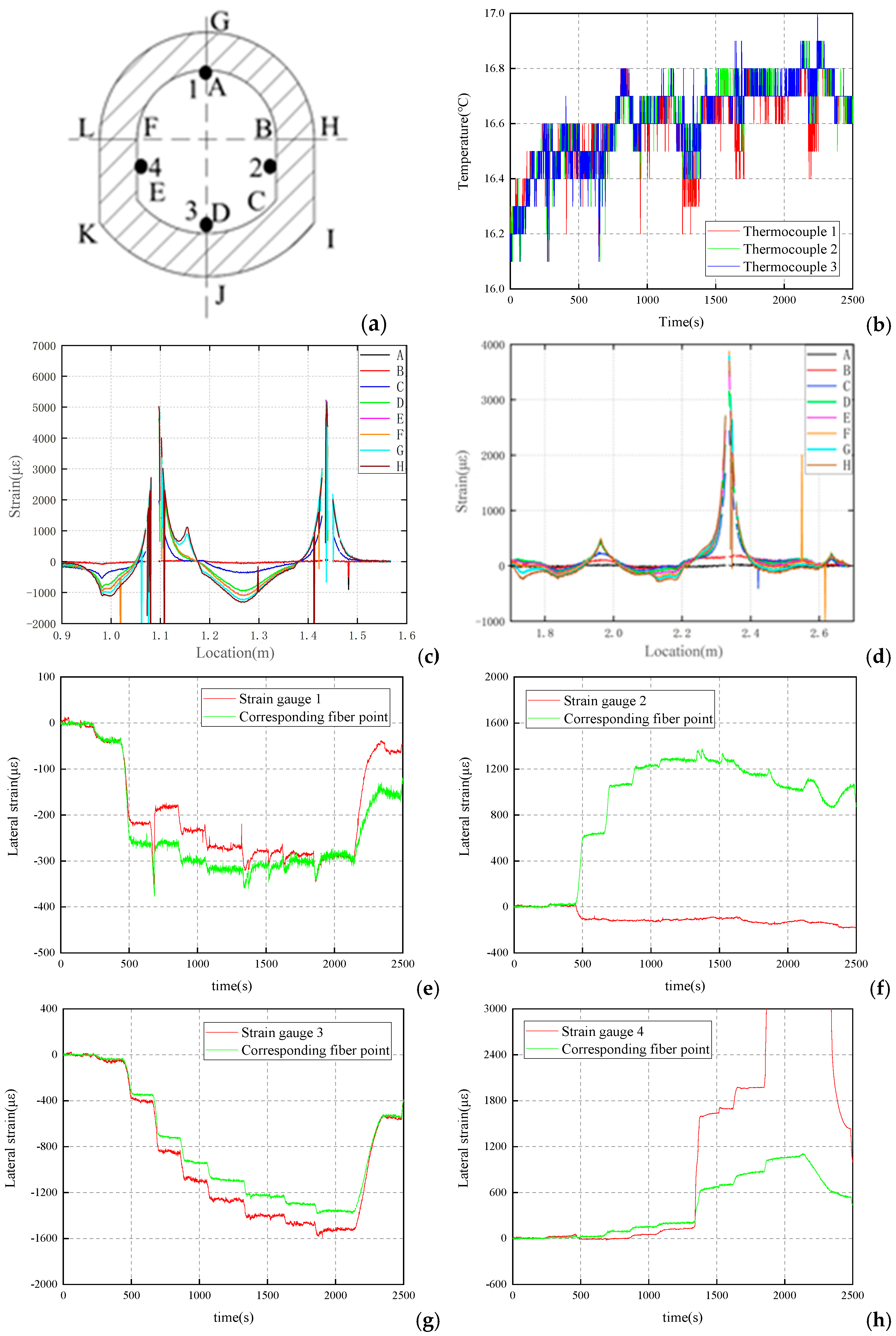
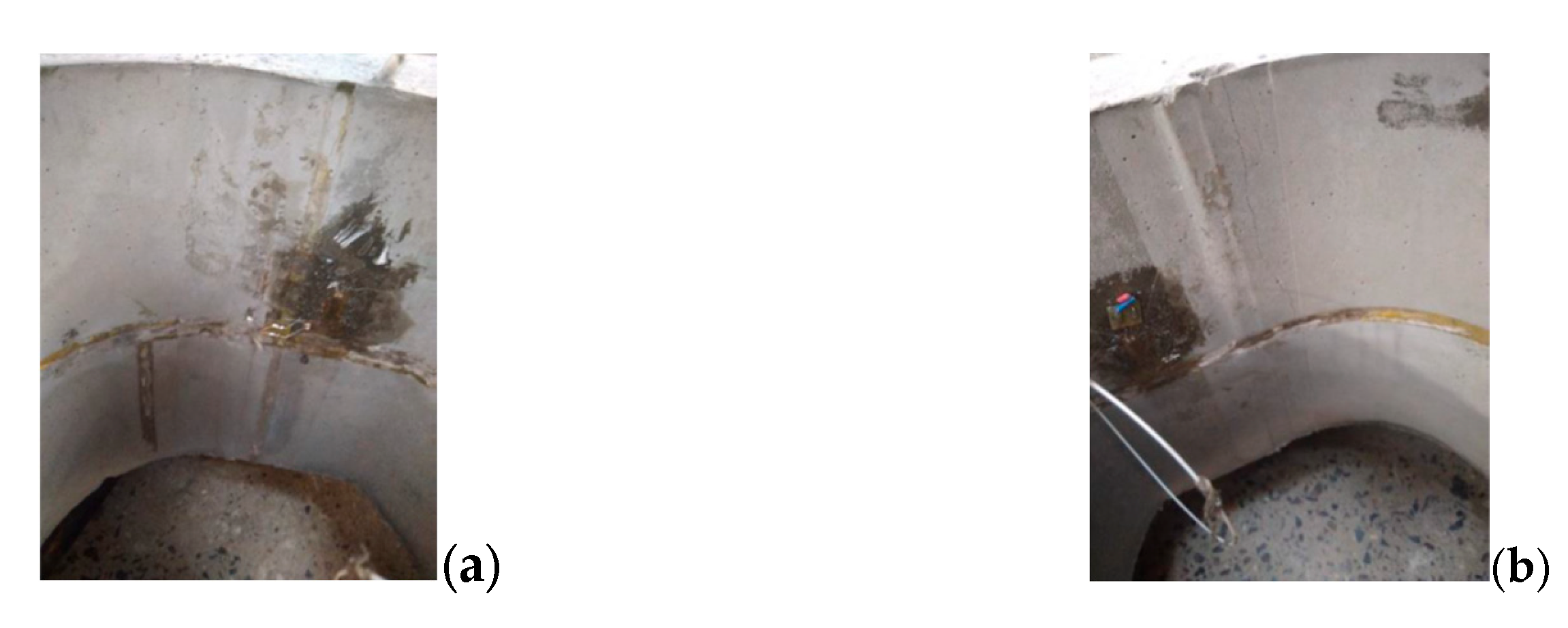

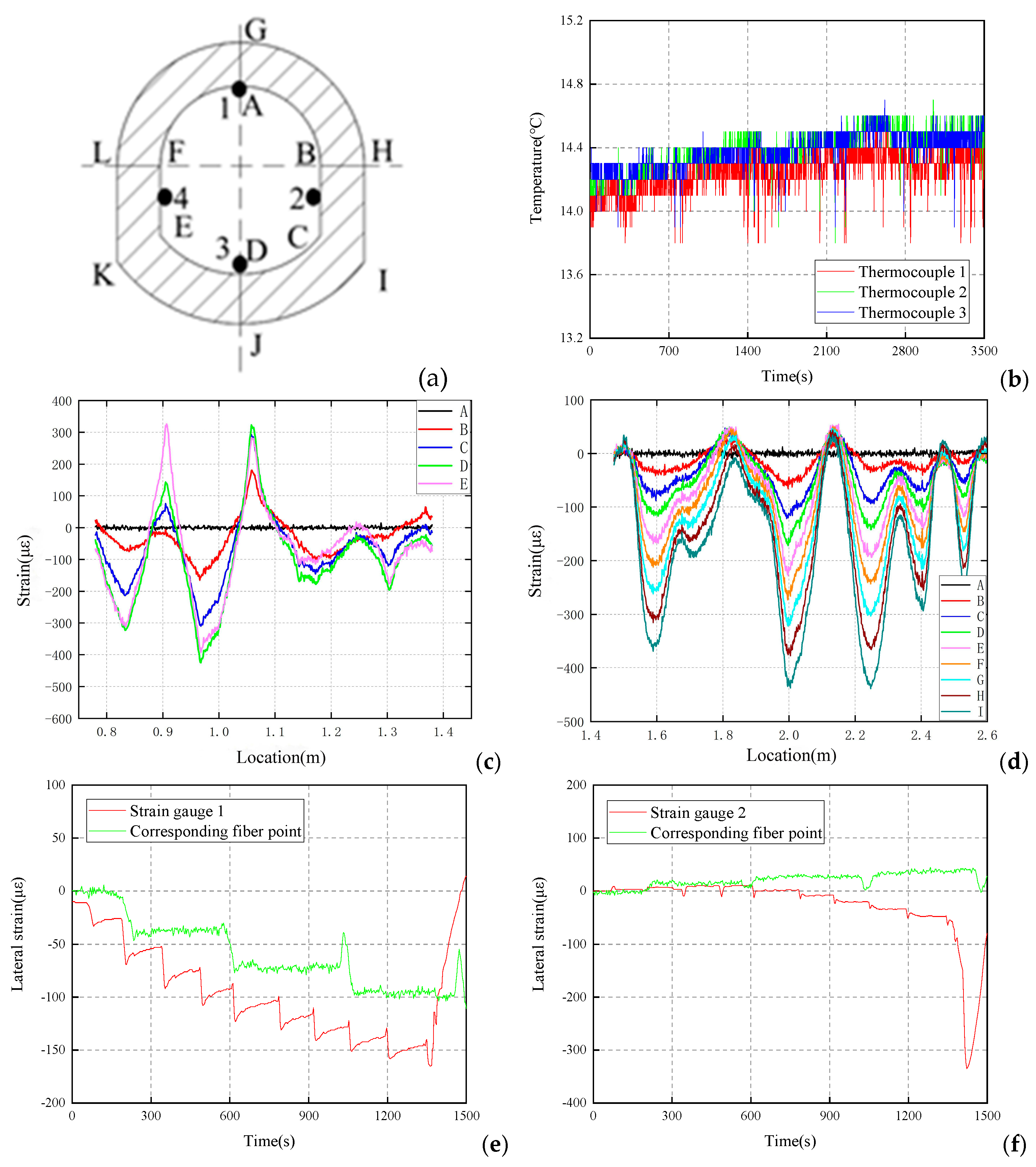
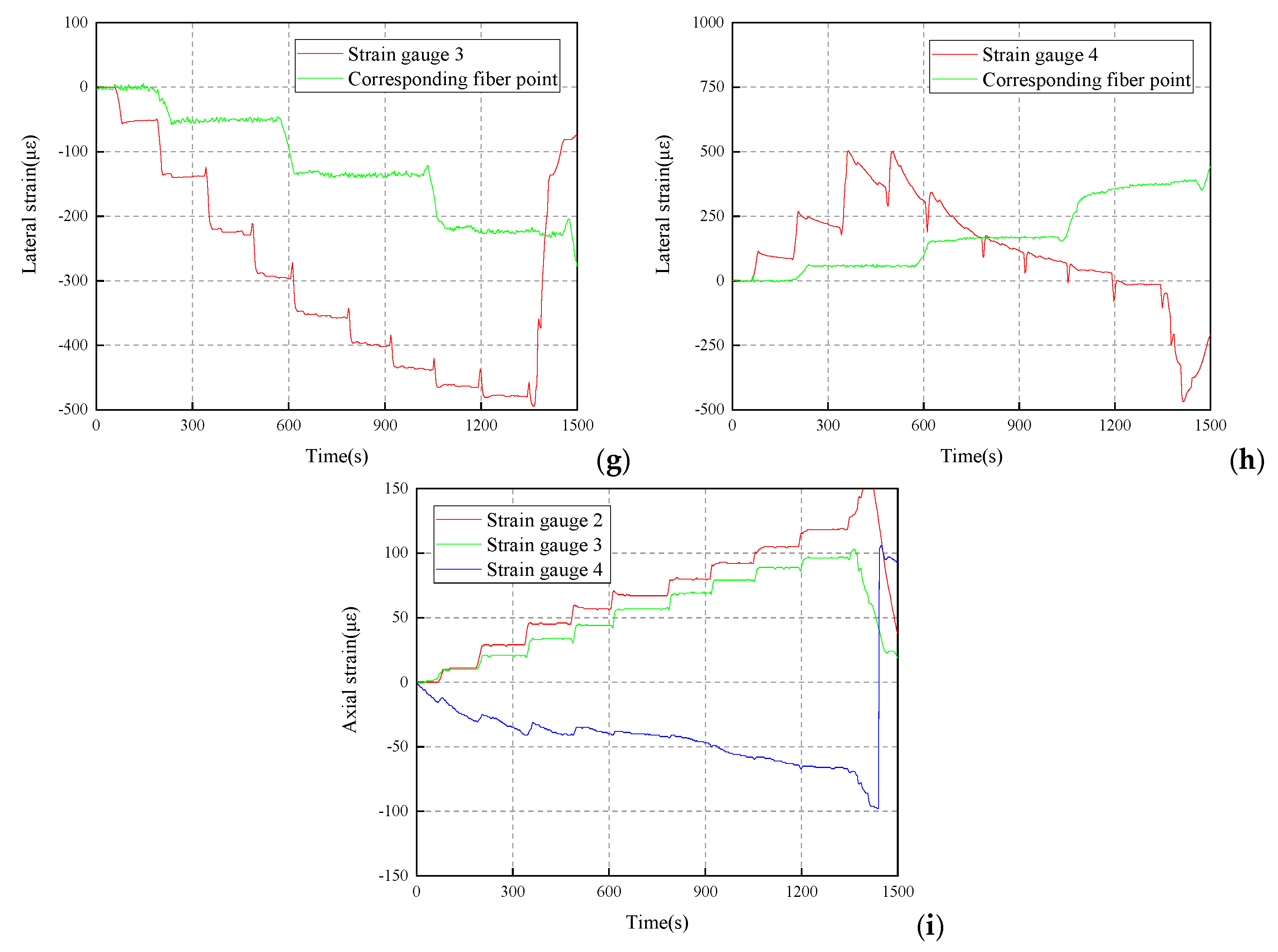

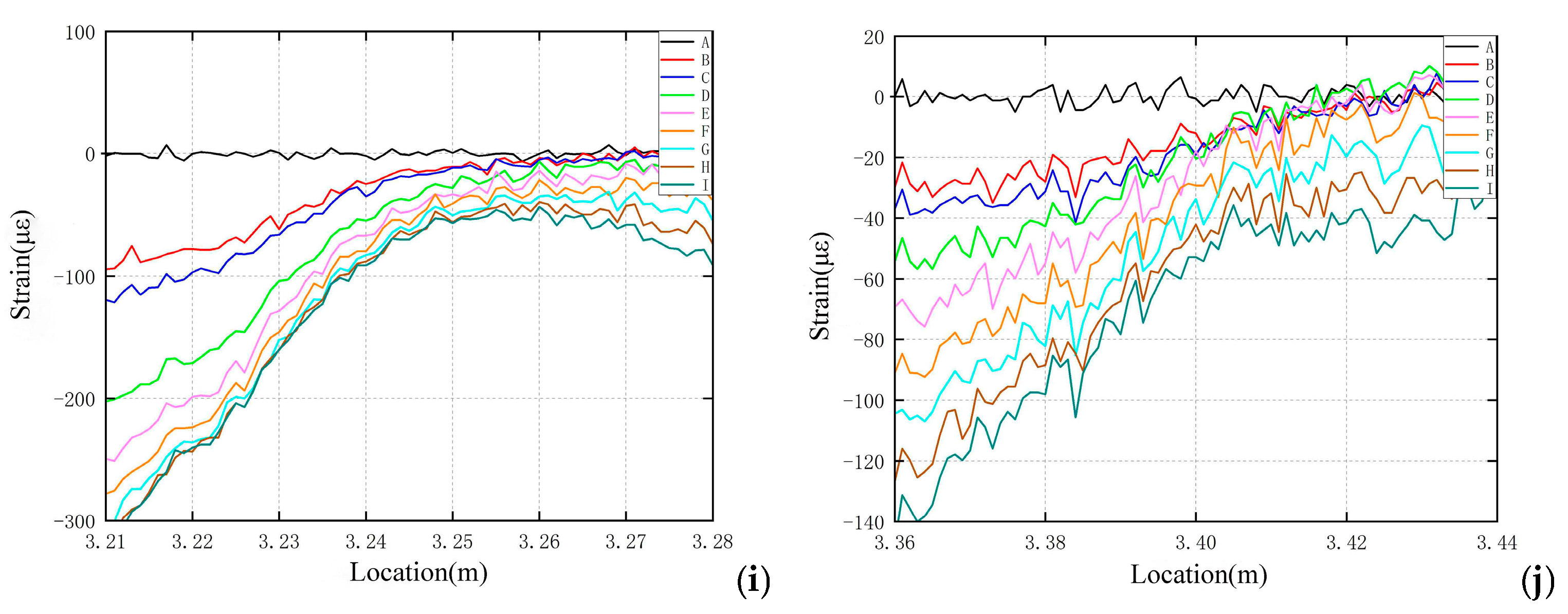
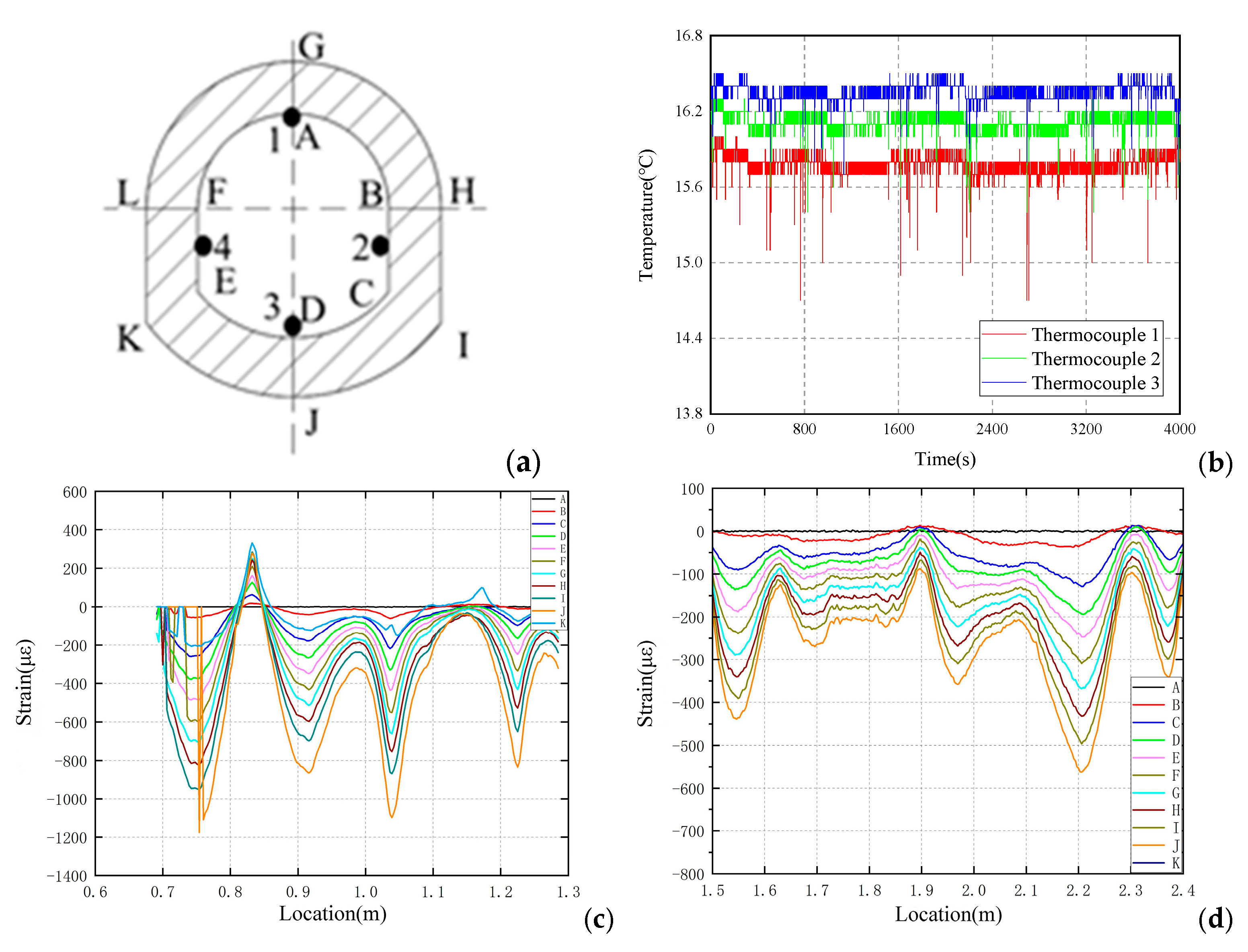
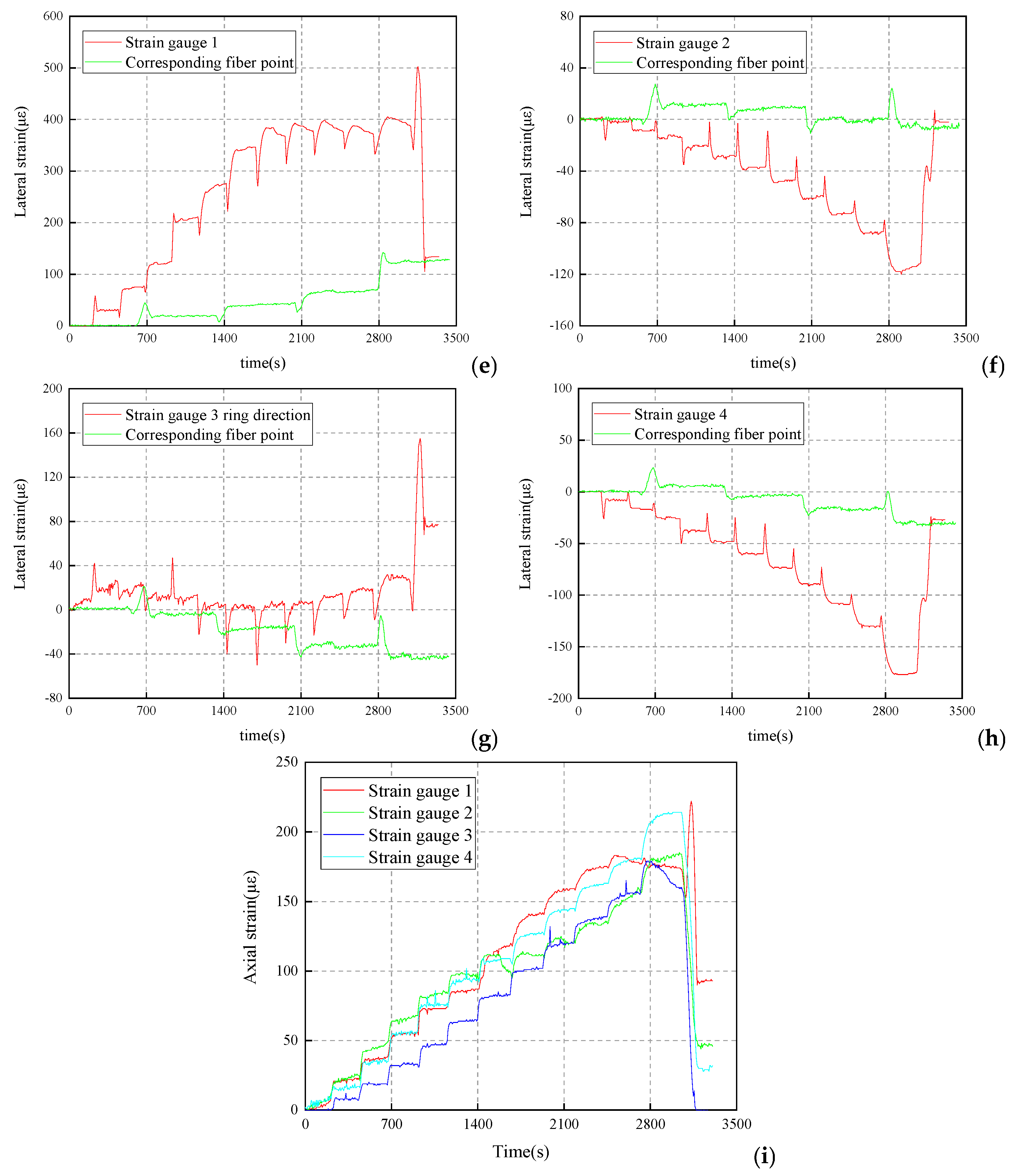
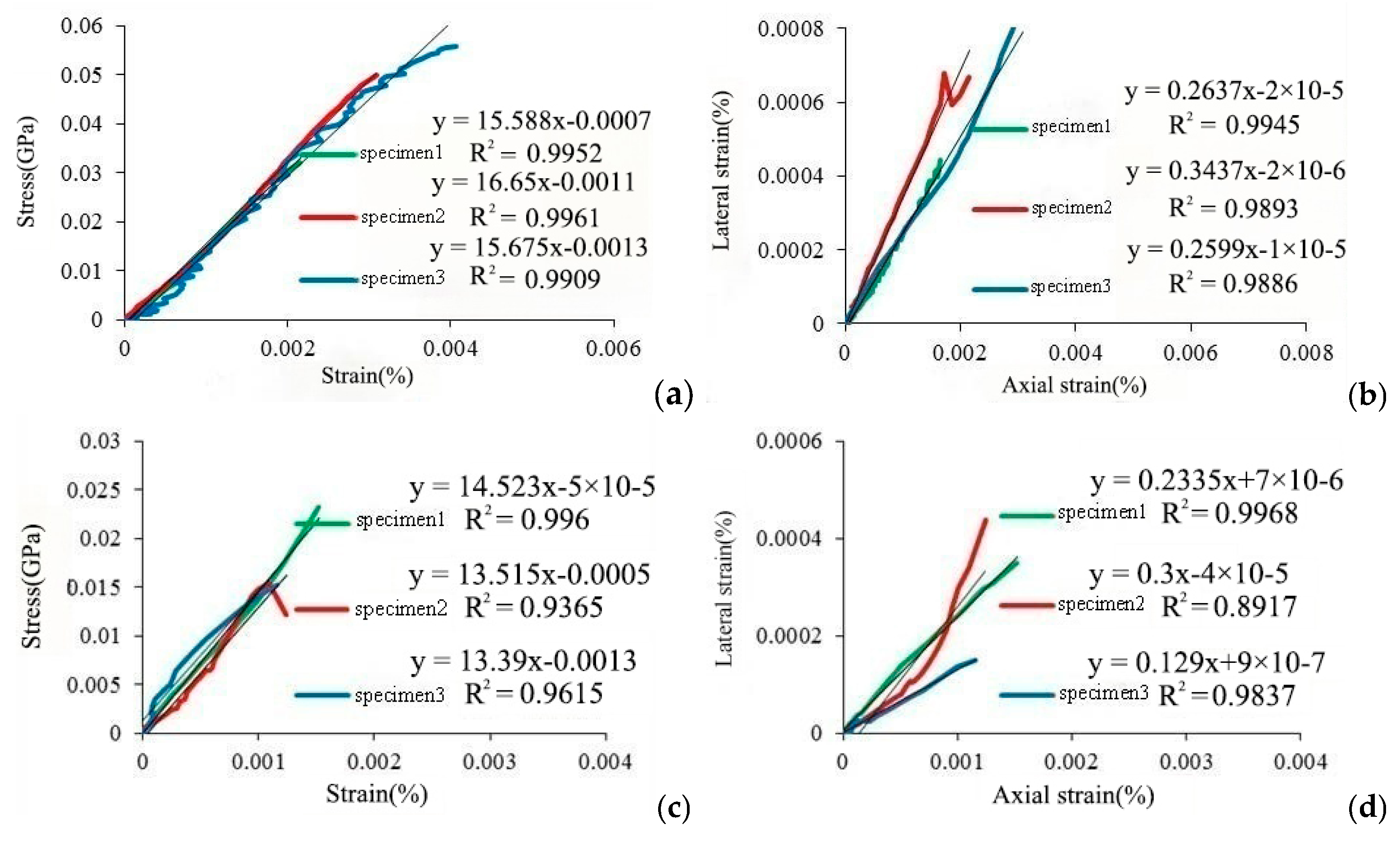
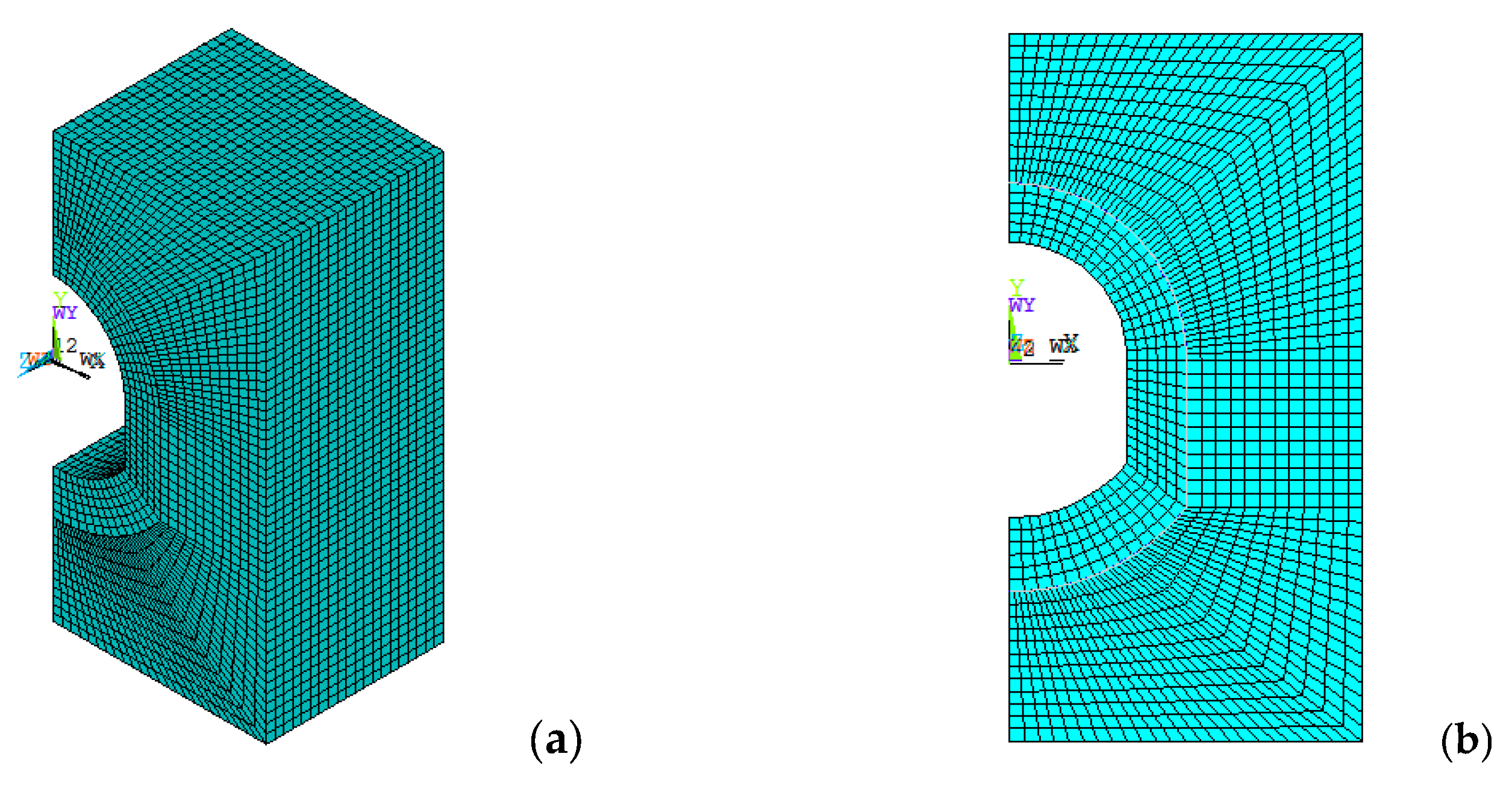

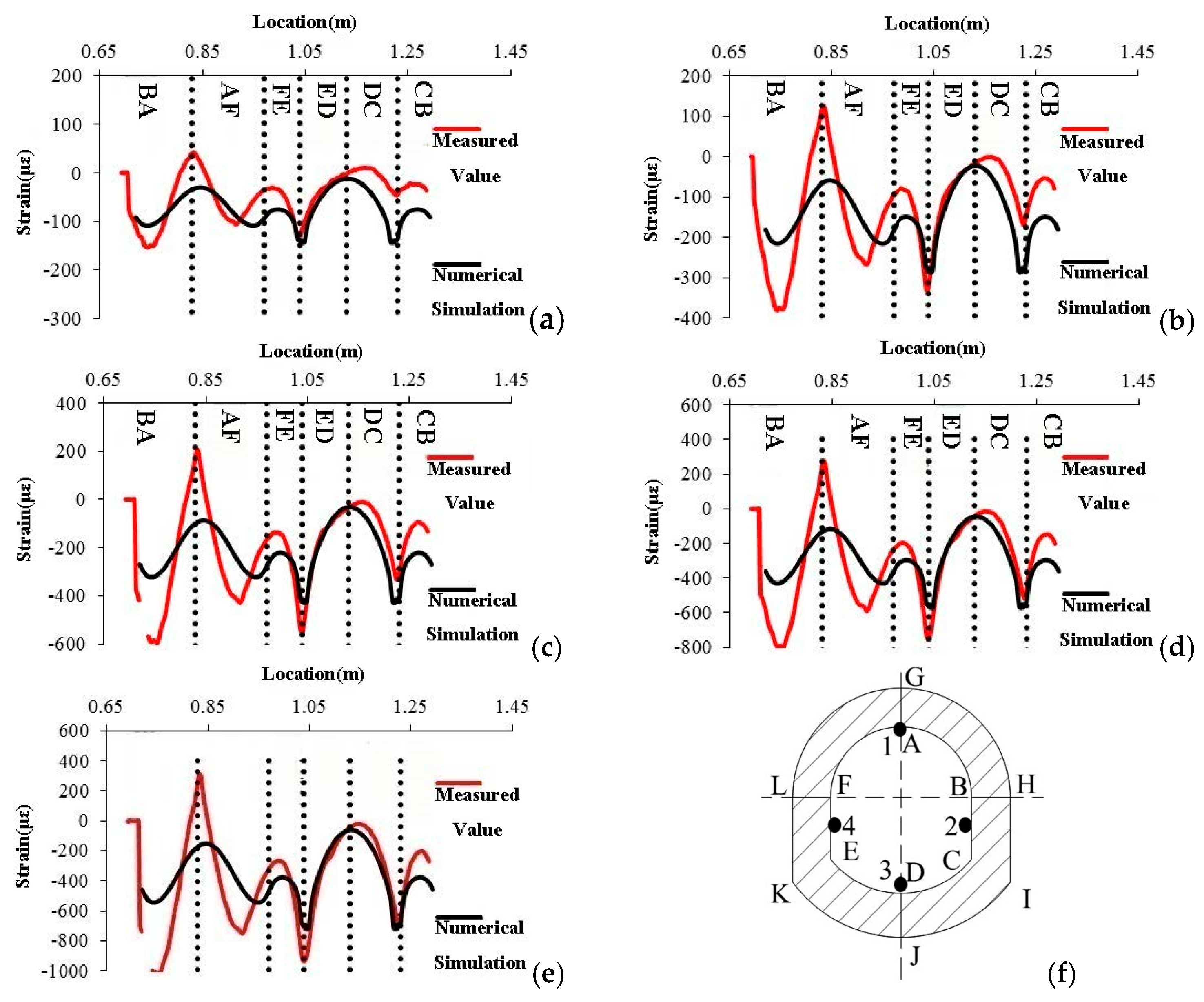
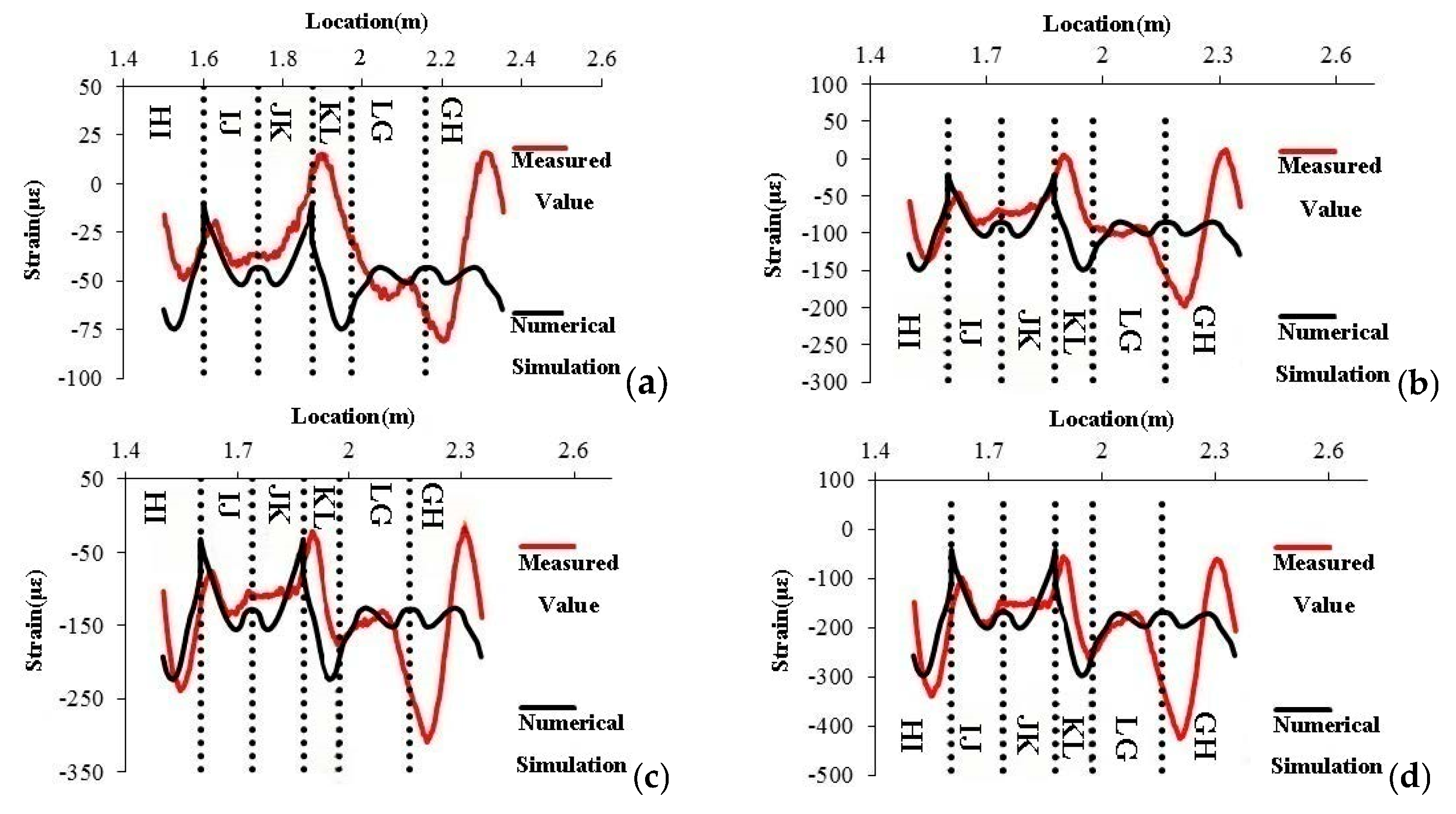

| Thickness of The Sidewalls and Crown of the Lining t2/mm | Thickness of The Lining Invert t1/mm | Outer Half-Span of the Shaft Lining B/mm | Inner Sidewall Height of the Shaft Lining H/mm | Outer Radius of the Lining Invert R/mm | Inclined Length of shaft Lining L/mm |
|---|---|---|---|---|---|
| 30 | 0.3 | 18 | 0.2 | 0.5 | 0.4 |
| 40 | 50 | 120 | 70 | 155 | 200 |
| Elastic Modulus of Shaft Lining /GPa | Poisson’s Ratio of Shaft Lining | Elastic Modulus of Surrounding Rock /GPa | Poisson’s Ratio of Surrounding Rock | Allowable Tensile Stress /MPa | Friction Coefficient |
|---|---|---|---|---|---|
| 30 | 0.3 | 18 | 0.2 | 0.5 | 0.4 |
| Thickness of the Sidewalls and Crown of the Lining t2/mm | Thickness of the Lining Invert t1/mm | Outer Half-Span of the Shaft Lining B/mm | Inner Sidewall Height of the Shaft Lining H/mm | Outer Radius of the Lining Invert R/mm | Inclined Length of Shaft Lining L/mm |
|---|---|---|---|---|---|
| 40 | 50 | 120 | 70 | 155 | 200 |
| Elastic Modulus of Shaft Lining /GPa | Poisson’s Ratio of Shaft Lining | Elastic Modulus of Surrounding Rock /GPa | Poisson’s Ratio of Surrounding Rock | Allowable Tensile Stress /MPa | Friction Coefficient |
|---|---|---|---|---|---|
| 0.4 | 0.3 | 20 | 18 | 0.2 | 0.5 |
Disclaimer/Publisher’s Note: The statements, opinions and data contained in all publications are solely those of the individual author(s) and contributor(s) and not of MDPI and/or the editor(s). MDPI and/or the editor(s) disclaim responsibility for any injury to people or property resulting from any ideas, methods, instructions or products referred to in the content. |
© 2025 by the authors. Licensee MDPI, Basel, Switzerland. This article is an open access article distributed under the terms and conditions of the Creative Commons Attribution (CC BY) license (https://creativecommons.org/licenses/by/4.0/).
Share and Cite
Yao, W.; Luo, T.; Yang, W.; Yang, Z. Physical Simulation Test and Numerical Simulation Study on Force and Deformation of Inclined Shaft Lining Using OFDR Testing Technology. Appl. Sci. 2025, 15, 5718. https://doi.org/10.3390/app15105718
Yao W, Luo T, Yang W, Yang Z. Physical Simulation Test and Numerical Simulation Study on Force and Deformation of Inclined Shaft Lining Using OFDR Testing Technology. Applied Sciences. 2025; 15(10):5718. https://doi.org/10.3390/app15105718
Chicago/Turabian StyleYao, Wenjie, Tingting Luo, Weihao Yang, and Zhijiang Yang. 2025. "Physical Simulation Test and Numerical Simulation Study on Force and Deformation of Inclined Shaft Lining Using OFDR Testing Technology" Applied Sciences 15, no. 10: 5718. https://doi.org/10.3390/app15105718
APA StyleYao, W., Luo, T., Yang, W., & Yang, Z. (2025). Physical Simulation Test and Numerical Simulation Study on Force and Deformation of Inclined Shaft Lining Using OFDR Testing Technology. Applied Sciences, 15(10), 5718. https://doi.org/10.3390/app15105718








